#triradially
Text
Wife sex with Hindi audio
Stepson observes his Stepmom Milf Raven Hart fucking to black BBC dicks and receiving a cumload of afro goo and sperm in her slut face
Macho dom me fodendo de calcinha
Babe has threesome fuck with guy and silicone lovedoll
Morena rabuda gritando alto no pauzao do namorado
French skinny girl fucked by a handsome boyfriend
Argentina casero
latin girl move so hot
As soon as naked beauty stands doggy style guy fucks her hard
pack de colegiala pendeja desnuda
#progressive#magnetizing#Grossetete#athetoid#Vorticella#arabinosic#triradially#ungrappled#kocham#managements#hornety#ails#ign.#Chmielewski#many-leaved#Lecompton#druith#broeboe#pangyrical#hoofers
0 notes
Text
harrahs casino joliet parking
Nurse flashing
Hard sex dog style. Fat man got a kick out on a whore.
Fuck the secretary
Kara Lee Gets a Creampie from Step Brother
Raw dawg riding twink
Lesbian babe licks horny milfs wet pussy
Nang Mwe San
Contratando shemale
Twistys - Two cute blonds lick pussy - Bree Daniels , Hayden Hawkens
#jabberingly#signalizes#triradiated#gilttail#decurrence#fugitating#counterpointe#azoology#Tegan#Thrymheim#panapospory#lobelin#flite#papistry#galactolysis#cross-pollenize#quiches#tangum#befuddles#reams
0 notes
Text
Bhabi and her male friend horny sex talk in bangla
Big Latina Ass vs Big White Cock
Amateur party orgy hd After School Detention
Indian Sex real story with neighbors
Busty Milf Shanda Fay Gives FootJob!
indian bangla Full family get together sex videi
student teacher desi girl home sex big cock indian teen
Fitness Rooms Big tits British ebony babe Jasmine Webb fucks sales rep
Hospitable gay daddy takes care of his straight house guest
Teen couple trying to be quiet I always knew that the ordinances
#buriable#bisects#tyrannicalness#circuitman#a-strand#snap-roll#buoyantly#orchidorrhaphy#triradial#aerodynamics#shellpot#doability#outstep#veneur#properest#revived#uncaramelised#hexapartite#Daltonian#spare
0 notes
Text

Trilobozoans (also known as triradialomorphs) are some of the more enigmatic members of the Ediacaran biota. In the past their unique three-way-symmetrical body plan was interpreted as linking them to groups like sponges, cnidarians, or echinoderms, but currently they're considered to be their own weird little phylum with uncertain evolutionary affinities, classified no more specifically than "probably some sort of early eumetazoan animal".
Lobodiscus tribrachialis is a newly-described member of this mysterious lineage. It lived in warm shallow marine waters covering what is now Southwestern China, and with an age of around 546 million years it's currently the youngest known trilobozoan, extending the group's time range by several million years.
About 3.7cm in diameter (~1.5"), it had the characteristic trilobozoan disc-shaped shield-like body, with a central depression surrounded by three triradially-symmetric lobes with branching ridges and grooves.
Its body would have been soft but fairly rigid, and it's not clear if it was capable of moving over the seafloor or if it had a more static lifestyle. Like its relative Tribrachidium it was probably a filter feeder, with the grooves on its surface directing water flow towards the central depression – and this surface ornamentation may also have been covered with cilia that actively caught and transported suspended food particles.
———
NixIllustration.com | Tumblr | Patreon
References:
Ivantsov, A. Yu, and M. A. Zakrevskaya. "Trilobozoa, Precambrian tri-radial organisms." Paleontological Journal 55 (2021): 727-741. https://doi.org/10.1134/S0031030121070066
Ivantsov, Andrey, Aleksey Nagovitsyn, and Maria Zakrevskaya. "Traces of locomotion of Ediacaran macroorganisms." Geosciences 9.9 (2019): 395. https://doi.org/10.3390/geosciences9090395
Hall, C. M. S., et al. "The short-lived but successful tri-radial body plan: a view from the Ediacaran of Australia." Australian Journal of Earth Sciences 67.6 (2020): 885-895. https://doi.org/10.1080/08120099.2018.1472666
Rahman, Imran A., et al. "Suspension feeding in the enigmatic Ediacaran organism Tribrachidium demonstrates complexity of Neoproterozoic ecosystems." Science Advances 1.10 (2015): e1500800. https://doi.org/10.1126/sciadv.1500800
Zhao, Mingsheng, et al. "A putative triradial macrofossil from the Ediacaran Jiangchuan Biota." Iscience 27.2 (2024). https://doi.org/10.1016/j.isci.2024.108823
Wikipedia contributors. “Lobodiscus.” Wikipedia, 29 Mar. 2024, https://en.wikipedia.org/wiki/Lobodiscus
Wikipedia contributors. “Trilobozoa.” Wikipedia, 10 Mar. 2024, https://en.wikipedia.org/wiki/Trilobozoa
#science illustration#paleontology#paleoart#palaeoblr#lobodiscus#trilobozoa#triradialomorpha#eumetazoa#animal#ediacaran#art#or maybe just precambrian disc golf
296 notes
·
View notes
Text

New employment seems to be secured and right after New Year's, I'm going to start. Absolutely glad it's going well.
Second round of Covid isn't nearly as bad as earlier in the year, but the general weakness and burnout are dragging on. Still, I found back into my wasteland of abandoned worldbuilding and worked out all the foundations I wanted to have in place since a few years now.
The little collage above shows a few early lifeforms of Sohaereàn, the Planitriangula or "flat triangles". They evolved from a triradial ancestor and branch off into different directions from this stage onwards.
147 notes
·
View notes
Text


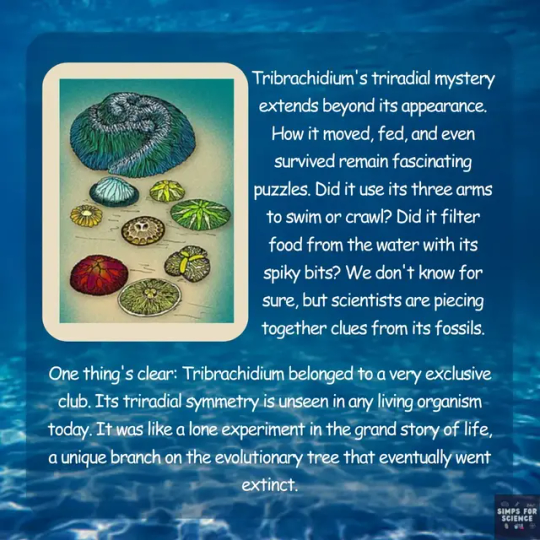

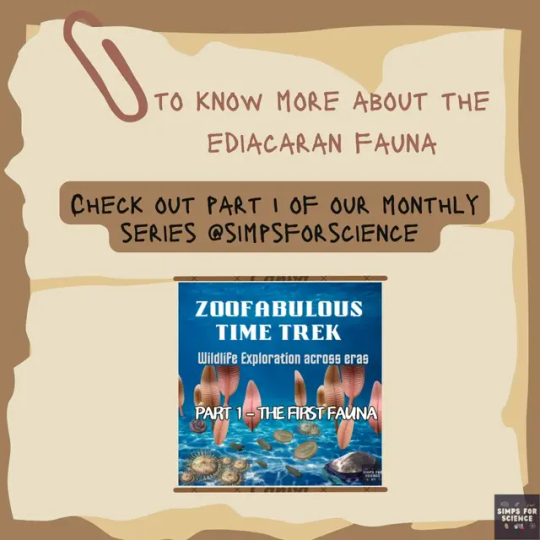
The strokes from Evolution's paintbrush🖌️ created a kaleidoscope of animal body symmetries. 🎨 Triradial symmetry is the rarest and most intriguing of them all !😃 Swipe➡️ to dive deeper🤿 into this rarest marvel of the animal world.To know more about the ancient animals, follow our monthly 🗓️series - Zoofabulous Time Trek!
📸Image credits:
1. Apokryltaros, Wikimedia commons
2. Aleksey Nagovitsyn, Wikimedia commons
3. Ghedoghedo, Wikimedia commons
4. Nobu Tamura, Wikimedia commons
#education#science#science facts#study blog#research scientist#discover#scicomm#zoology#earth#animals#symmetry#fauna#wildlife#precambrian#ediacaran#explore#evolution#paleontology#archaeology#fossils#biology#ancient animals#nature#charles darwin#geology
56 notes
·
View notes
Note
Your Palindromes are so shaped! (Triangle)
I just found out about them today and I haven’t been able to stop thinking about them, they’re so so neat! What was your inspiration for creating them? If you don’t mind me asking
Thank you so much! Palindromes were created when I was trying to figure out the environment for another species, phonies (made by @quimiri) and other critters for them to coexist with. We were creating an ARPG for them over on deviantart, and they needed some flavor to their world! I was trying to make phonies look "out of place" in their setting, and figured a good way to do that was to mess around with the symmetry of every animal aside from them. I was thinking about some symmetry types that aren't seen quite often and settled on triangular, since we haven't seen any cool triradial creatures since the ediacaran. I couldn't think of anything cool to do with triangles, so I just made tents and left it at that.
But later, I revisited the idea and worked with the body plan some more, and devised more trilateral and biradially symmetrical critters. Palindromes were a "what if the prisms looked kind of like doggies?" and then it just went from there!

72 notes
·
View notes
Text
Clade of the Day: Pluriptera
Welcome to Clade of the Day, where we cover different groups of organisms on the collaborative project Sagan 4. Today's clade is the class Pluriptera, which includes all centifins and their derivatives.






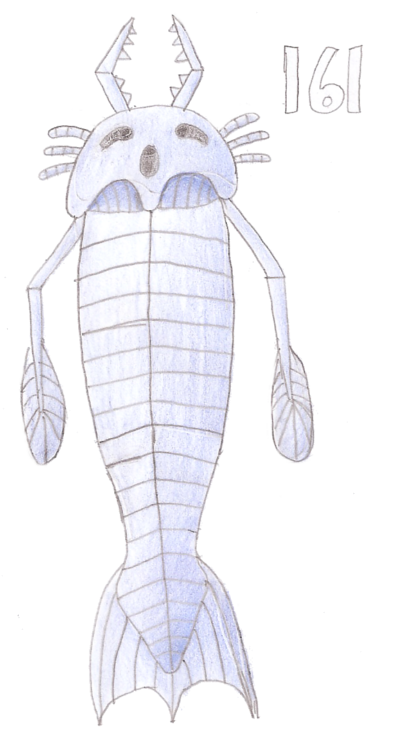
(sources: x/x/x/x/x/x/x)
The centifins are close relatives of true anipedes which, as their name implies, ancestrally had many fins. Some centifins lean arthropod-like, similar to their anipede cousins, but others skew towards a more annelid-like appearance, as is basal to segmentocaudzoans. They are unique for having a 3-sex system, where 3 individuals must meet to mate successfully. Modern species are mostly grouped into the wrigums, the slitherworms, the arthrofins, the inchinches, and the echofins. Very few modern groups really have so many fins compared to their ancestors.
71 centifins are recorded on the wiki. They are perhaps the most anatomically diverse of the segmentocaudazoans, producing legless worm- and snake-like forms, inching detritivores, hulking apex predators with heavy exoskeletons, and even a bizarre extinct order of triradially symmetric carnivores. They are no stranger to extinction events, however, and suffered great losses to their diversity over time, especially as a result of the end-somanian impact event, which wiped out the large marine carnivorous forms, and the snowball event of the Bloodian period, which of course was responsible for the extinction of most organisms at the time.
--
Homepage | Forum | Discord
#sagan 4#speculative evolution#clade of the day#speculative biology#spec evo#creature design#species concept#creature concept#science#taxonomy#worldbuilding#spec bio#alien species#original species
6 notes
·
View notes
Note
You say you dug up those noncanon concepts for the 2017 beta draft from your files? What other ideas do you have from there, are they also Hamster's Paradise early rejected ideas?
Mostly just a jumble of old rough doodles on an older drawing app whose name I can't even remember, eh I've found Sketch much better anyway.
Most are earlier doodles of the beta Hamster's Paradise post, nothing really new there, though there were also some random art of all sorts of a spec evo grab bag of other ideas I had back then just playing around with speculative evolution tropes, years ago.
Some notable non-Hamster's Paradise ones:

Pentapodal indricothere-like kangaroo descendant that turned its tail into basically a fifth leg. Also some carnivorous macropods that may have influenced the loupgaroos and the harmsters.
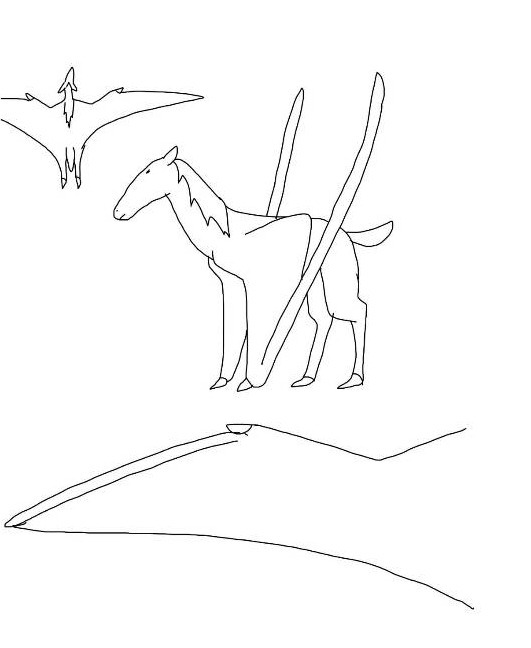
An attempt to wyvern-ize a pegasus after hearing some spec evo explanation on why the dragons of Westeros are all wyverns for "realism".

Some big headed baleen whale azhdarchids. How and where and why these could evolve, I have no clue.

A semi "realistic" take on Meowth from Pokemon interpreting it as less of a cat and more of a feline-esque primate with the coin as a brightly-colored display organ. Also probably would involve the heightened intelligence and apparently latent ability to learn human language only some individuals learn.

...whatever the hell this is. I don't even know anymore, it was a long time ago.
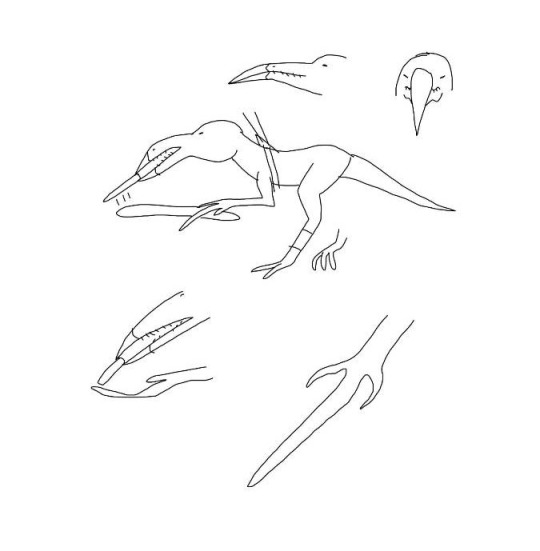
Sapient "dinosauroid" descended from probably some generic maniraptoran, with the half-beak and teeth used as a third manipulatory organ. Also long middle fingers for some reason, maybe a scansoriopterygid?
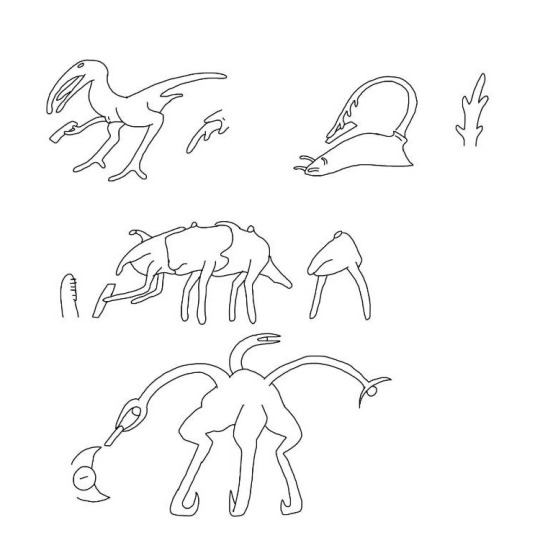
And on the topic of sophonts and manipulatory organs, some attempts at sapient aliens as un-humanoid looking as possible, including some modular bipeds and some kind of triradially symmetric one that uses the eyelids of its three eyestalks as manipulators.

An entirely scrapped project labeled "Lystronia" with the premise of an alternate timeline where the Permian Great Dying was worse and killed the archosaurs and cynodonts too, and with no crocodilians, dinosaurs, pterosaurs or mammals to eventually outcompete them the dicynodont Lystrosaurus took over like it did irl, but then stayed in prominence and dominated the Mesozoic and Cenozoic.
And yep that's basically all, as well as the pop-culture reference one-offs, the planet of the pseudosnakes one, and a Tullimonstrum seed world that went nowhere as we simply didn't know much about what phylum it even is. Hamster's Paradise was the only one that really took off, conceptually.
25 notes
·
View notes
Note
the spine is a segmented body part & thus has always been easily repeatable (see: convergently snaky lineages of reptiles) but AFAIK chordate organs never have been—fish can’t easily duplicate their hearts either—and it’s a combination of cephalization, segmentation, and metamerism. Cephalization tends to produce organs like complex brains, which then can’t be easily repeated throughout your segments for energy cost reasons. Segmentation and metamerism describe structural elements in development and whether something can be easily repeated; things which are segmented are easy to duplicate, things which derive from metameres can also be repeated easily, but if a body part isn’t segmented or your metameres fuse together in development into complex tagmata (the insect head, for instance) they get hard to repeat again.
I’m pretty sure this “split” (having many unfused metameres vs. having very few) can’t be exactly pinpointed but I would guess most of it for chordates happened sometime after the deuterostome/protostome split, and more of it happened sometime around the Echinodermata/everyone else split, echinoderms being the only deuterostomes I can think of with even vaguely similar modularity to arthropods. It’s possible for many sea stars to just add legs in development (Pycnopodia helianthoides develop at least 16 legs but may have as many as 24) with no ill effects.
It also seems easier for the Bilateria generally to go from singular to paired than from anything to triplicate (see: zero extant animal lineages with triradial symmetry, and only one extinct, RIP Trilobozoa; ancient fish probably had one swim bladder, but most modern species have two; cephalopods have three hearts but it’s actually a singular systemic heart and a pair of branchial hearts). Bilaterians, echinoderms excepted, really like pairs of things.
fascinating! thanks for the info.
18 notes
·
View notes
Note
🧬🦕
Is it cool if I get a little personal? Let me tell you about one of the coolest things I've ever gotten to do: two summers ago, I got to see the Archaeopteryx fossil at the Wyoming Dinosaur Center, which is also the only specimen on display in North America.
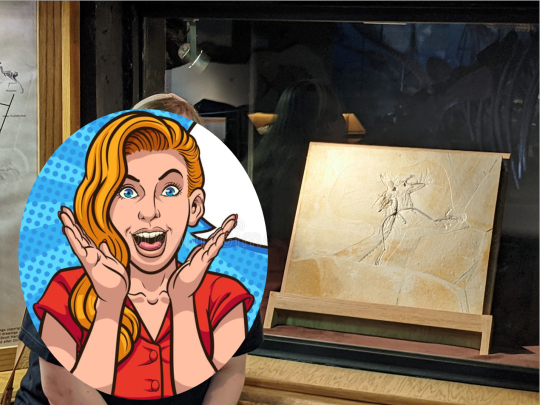
Trust me when I say that the stock clip art that I chose to obscure myself is 100% representative of the face I'm making here. If anything, the smile isn't big or goofy enough.
Here's a close-up and a diagram to show up-close what I'm actually looking at. Note the impressions of wing and tail plumage!


Diagram source
You've probably at least heard of Archaeopteryx: it's a transitional genus dating to the late Jurassic and the earliest example of what we could consider a "bird" which retains many ancestral "reptilian/dinosaur" characteristics.
Now, "bird" and "reptile" are kind of arbitrary words here because reptiles are a paraphyletic group. DNA tree-building models and sequence alignment evidence demonstrate that there's simply no way to define "reptiles" which does not also include birds; the definition of a "reptile" is a sauropsid that is not a bird. Thus, we know that all birds have a reptilian common ancestor because they arose as a branch within the sauropsid clade. Archaeopteryx is an ancient sauropsid with both avian and reptilian features; this is what we mean when we call it a transitional genus.
But why did this transitional fossil make me smile so big that my cheeks went numb? There are several reasons, I think:
Despite its transitional characteristics, most scientists consider Archaeopteryx the first bird in the fossil record. It was also the first direct evidence that birds evolved from reptilians (the first Archaeopteryx specimen was discovered just three years after On the Origin of Species was published). Just on a basic, fundamental level, this genus is of immense scientific and historical importance and standing next to it felt like meeting a celebrity.
The particular specimen that I got to see was super cool! Unlike most Archaeopteryx fossils, which tend to be preserved on their sides, this one is preserved on its stomach with its head in three-quarter view. Thus, it's the only specimen in which the palate bones are clearly visible, and it's tetraradiate (as in non-avian theropods) rather than triradiate (as in other avians.) The palate is one of the most important features in terms of saying, "yeah, we consider this a modern bird."
Its feet are also really well-preserved! The specimen I saw clearly demonstrates that Archaeopteryx didn't have a reversed toe, but does have a hyperextendable second toe. This means that unlike modern birds, it probably had limited ability to perch; instead, it had tearing claws like a dinosaur.
But even in contrast with other important transitional fossils - say, the Archeoceti of Wadi al Hitan in Egypt, which are amphibious ancestors of modern whales - Archaeopteryx is something special. There's a certain romance to the idea of the first bird: feathers that actually enable something like flight! (Like Buzz Lightyear, Archaeopteryxes' wings were probably used for "falling with style.") But still, there's beauty in Archeopteryx that we don’t see in other transitional fossils. In his poem "The Archeopteryx's Song," Edwin Morgan captures this glory far better than I ever could:
I am only half out of this rock of scales.
What good is armour when you want to fly?
My tail is like a stony pedestal
and not a rudder. If I sit back on it
I sniff winds, clouds, rains, fogs where
I'd be, where I'd be flying, be flying high.
Dinosaurs are spicks and
all I see when I look back
is tardy turdy bonehead swamps
whose scruples are dumb tons.
Damnable plates and plaques
can't even keep out ticks.
They think when they make the ground thunder
as they lumber for a horn-lock or a rut
that someone is afraid, that everyone is afraid,
but no one is afraid. The lords of creation
are in my mate's next egg's next egg's next egg,
stegosaur. It's feathers I need, more feathers
for the life to come. And these iron teeth
I want away, and a smooth beak
to cut the air. And these claws
on my wings, what use are they
except to drag me down, do you imagine
I am ever going to crawl again?
When I first left the crag
and flapped low and heavy over the ravine
I saw past present and future
like a dying tyrannosaur
and skimmed it with a hiss.
I will teach my sons and daughters to live
on mist and fire and fly to the stars.
And like, that’s it, right? Obviously no Archaeopteryx could possibly have any concept of bird or dinosaur. No fifteen million year-old creature could have dreamed eagles or pigeons or penguins. But God did.
God knew from eternity that a creature called Archaeopteryx would exist. He knew that it would have a dinosaur’s sharp teeth and bony tail and yet wings and feathers to glide with. He alone could imagine a world in which creatures sharing a close relative with Archaeopteryx would have more feathers for the life to come; that the lords of the skies would be in the next egg’s next egg’s next egg.
He knew that Jesus would tell his disciples to look at birds when they were worried; that Gerard Manley Hopkins would write a poem dedicated “To Christ our Lord” in which he extolled “My heart in hiding/ Stirred for a bird, – the achieve of, the mastery of the thing!” God knew that the albatross, so like and yet unlike Archaeopteryx, would live its life on the wing, flying over oceans ten thousand miles at a time, and that Samuel Taylor Coleridge (a devout Christian) would write a poem in which an albatross was Christlike, and that C.S. Lewis would write a book in which an albatross was Jesus and whispered courage to a little girl in the dark. God knew that one day, in the summer of 2021, I would stand beside this fossilized evidence that Archaeopteryx really lived, staring and squinting to see all its features, grinning like an idiot and thinking, “Do you imagine I am ever going to crawl again?”
#i'm legit tearing up#i think i've gotten well away from the concept of 'fun fact' i'll reign it in a little for the next one#i love you archeaopteryx#ask me hard questions#all truth is god's truth#dinosaurs make me happy#fossils! dun dun dun
9 notes
·
View notes
Note
Specifically the creature that makes the least sense to me in Pikmin is the Quaggled Mireclops. Digging the triradial symmetry though.
It’s possibly a composite organism or another moving plant
Or both
3 notes
·
View notes
Text

O Only Son of God, receive me into Your wisdom. You are the head of all the sons of men. You are their heavenly comprehension, illumination and jubilation.
You are the One who thinks the same goodness in all men: the same thought and the same light. A man recognizes another man through You. A man prophesies to another man through You.
Through Your voice men hear each other. In Your language they understand. Truly, You are the Ultimate Man, for existentially all men are in You and You are in each.
You build the mind of man, and Your shadow demolishes it. You have formed all forms, and You have stamped all of them with the seal of Your wisdom. You have fashioned all vessels from clay and have filled them all with the song and joy of the Holy Triunity, but Your shadow has dripped a drop of sorrow into each vessel, with which the sorrowful inscribe griefs on You.
O Majestic Lord! You dance on Your Mother's lap, quickened by the All-Holy Spirit. Direct my mind to Your mind, and with Your radiance cleanse it of sorrowful thoughts, of sorrowful forebodings, of sorrowful intentions. O my Majestic Lord!
You fill the whole soul of Your Mother, all Her virgin breast; and there is nothing in Your Mother's soul except You. You are Her radiance and Her voice, truly Her eye and Her song. You are the pride of the Holy Spirit Lord--His activity and His fruit--His fascination and His admiration! You, my Majestic Lord, who dance on Your Mother's lap, quickened by the Holy Spirit!
You are the courage of the Holy Trinity, Its heroism and Its history. You dared to let one triune ray into chaos and darkness, and the world became--a miracle, that the eye can not see nor the ear hear, O Creator of the eye and the ear.
And this whole miracle is just a pale picture of You, just a copied and distorted likeness of You in pieces of a half-darkened mirror.
My heart yearns for Your complete image, O Son of God. For it is bitterness to be a fragment of Your image, drifting in-securely on an ocean of darkness.
Shatter the narrowness of my soul, O expanse of the triradiate Godhead!
Illuminate my mind, O light of angels and creatures. Make my life logical, Most Wise logos of God. Make my soul a virgin, and be her eye and her song.
Prayers by the Lake
Nikolai Velimirovich
5 notes
·
View notes
Text
BOSTROM 37

BOSTROM 37 est un solide et performant voilier de construction Suédoise du chantier Porali marin qui produisait à l’époque les coques Hallberg Rassy et Najad.
Il présente un excellent design ,un grand cockpit central et un confort à bord. Doté d’un lest de 3.4t pour 8t de déplacement et d’un mât traversant 17.7m avec son gréement surdimensionné, c’est un bateau conçu et adapté aux longs parcours.
“FLAIR” à été très bien suivi, entretenu et préparé pour un prochain voyage.
Certification Lloyd’s
Moteur Volvo Penta, modèle MD21A- 45cv diesel (4000h) – fonctionne parfaitement, entretenu avec soin.
Échangeur (2023), collecteur échappement (2023), coude échappement (2019), alternateur et pompe de gavage remplacé en 2023, vidange moteur + mise en route 03/2023, circuit de refroidissement . Changement joints.
Capacité gasoil 125l en inox + 3 jerricans 20l.
Vitesse moyenne 5 nds, conso moyenne 3l/h.
Ligne arbre, hélice tripale repliable Volvo, presse étoupe à tresse.
Aménagements :
Cockpit central : 1 cabine arrière propriétaire (modifiée plus grande qu’à l’origine par le chantier à la demande du 1er propriétaire) avec passage intérieur, cabine avant double, salle séparée servant de stockage, réserve ou atelier.
Salle d’eau avec WC manuel + réservoir eaux noires (à rebrancher), douche intérieure , eau sous pression froide/chaude, capacité eau 300l polyester +70l en inox.
Coin cuisine avec évier double, réchaud 3 feux gaz + four, rangements.
Voiles & Accastillage :
Grand voile Sailonet (2018) 37m2 très bon état 3 ris avec lazy bag – Génois Véga voile triradial 56m2 (usé), trinquette (20m2) + tourmentin neuf (4m2) sur étai largable.
Hâle bas rigide, tangon de Spi télescopique ferlé à l’avant du mât + accastillage disponible (possibilité de tangonner le génois), Gréement dormant Harken surdimensionné, palan de GV Harken, winchs Lewmar selftailing 2×48 – 2×40 – 2×32, enrouleur génois Reckmann, frein de bôme. Ridoir pataras + bas étai remplacé.
Électronique :
Centrale navigation c80 (Ordinateur portable Lenovo fournit est installé à la table à cartes avec Open Cpn installé, cartes fournies, GPS & AIS connectés pour la navigation).
Loch spedo Arimar ST 600 (2017), Sondeur Arimar P219, Girouette/anémomètre, VHF fixe ic-m601 avec Asn,GPS, Pilote auto ST 6001 vérin électrique, Ais Amec camino 108 (07/2021) avec antenne.
Divers :
Électricité : 440A de batteries servitude (4×100) 02/2022, 440w de panneaux solaires 02/2022, Victron régulateur mppt 100/30, Chargeur Victron 30A,Victon Phoenix inverter 1200va, Contrôleur de batteries Victron, prise de quai, feux leds int, feux leds ext + tête de mât, convertisseur.
Chauffage Webasto (dans tout le bateau), plateforme de bain avec échelle, 3 pompes de cale électrique + 1 manuelle, machine à laver Candy 4kgs (2021).
Sécurité : Balise Epirb expirera en 2032, plb expirera en 2024, Radeau de survie 4 places révisé en 2022, rations alimentaire de secours 6x500g.
Annexe Plastimo horizon 2.60m fond gonflable année 2019 sur bossoirs + Honda 2.3cv.
Guindeau électrique Lofrans Cayman 1000w avec télécommande filaire + télécommande + mouillage 50m de chaine 8mm + ancre delta 16kgs + ancre plate secondaire + grappin inox.
Aussières 50m x2, amarres, pare battages, jerrycans, sellerie intérieure en Alcantara, Dodger cristal neuf et bimini en bon état, panneau de pont changé 2022, chauffe eau 20l, armement de sécurité et de vie à bord.
Poids : 8000kgs – Lest en fonte : 3500 kgs – Hauteur sous barrot : 1.92m- Pavillon :FR
Bateau construit avec certification Lloyd’s
3ème propriétaire depuis 2021 (Canaries, Ibiza , Martigues).
Read the full article
0 notes
Text
Comparison Results between Patients with Developmental Hip Dysplasia Treated with Either Salter or Pemberton Osteotomy _ Crimson Publishers

Comparison Results between Patients with Developmental Hip Dysplasia Treated with Either Salter or Pemberton Osteotomy by Dello Russo Bibiana* in Crimson Publishers: Peer Reviewed Orthopedic Research Journals
Background: Acetabular dysplasia is defined as the alteration of the normal relationship in the depth and orientation of the acetabulum typically accompanied by a valgus abnormality and ante version of the proximal femur. Different types of pelvic osteotomies were designed to improve the relationship between these components in order to anteversion improve femoral head coverage. The most commonly used techniques are the Salter innominate osteotomy, a re-directional osteotomy, and the Pemberton osteotomy, which is a remodelling technique.
Purpose: The aims of this study were:
a. To compare angle variation on pre- and postsurgical X-rays of patients who underwent correction of acetabular dysplasia with either Salter or Pemberton osteotomy as the primary treatment.
b. To evaluate post-osteotomy premature triradiate cartilage closure during follow-up in both groups.
c. To evaluate residual dysplasia in both groups of children that may have needed an additional acetabular procedure before reaching the age of 10 years.
Patients and method: A retrospective cohort of pediatric patients who underwent surgery because of congenital dislocation of the hip at the Department of Traumatology seen at the pediatric hospital Prof. J. P. Garrahan between 2000 and 2010 was assessed. The children were divided into two groups: 49 children who underwent Salter innominate osteotomy and 47 the Pemberton osteotomy, performed by orthopaedic surgeons with more than 10 years. Children who had received previous surgical or non-surgical interventions (corset or splints of any type, preoperative traction, etc.); children with teratologic dysplasia, syndrome-associated dysplasia, myelodysplasia, orneurological diseases werexcluded from the study.
Results: Correction of the dysplasia with normal angle values (AI: 20°; CE: 9-12 to 25°, and 13-20 to 26-30° ADR 60%) was achieved in 40 hips (83%) in the Pemberton group, and in 22(45%) of the Salter group, with a statistically significant difference (P< 0.001 - Odds ratio 2.17). Intra- and inter observer reliability was assessed using the kappa coefficient, which show it to be good (0. 92). For agreement on the definition of cartilage closure a kappa of 0.73 was found (p 0.001) in this series, X-rays that showed premature closure of the cartilage were more common in the cases treated with the Pemberton technique (52%). Avascular necrosis (in its different stages) was not present before operation. Therefore, avascular necrosis was observed principally (23%) in the Salter osteotomy group, in the group to the group without femoral shortening when compared with the Pemberton osteotomy group (13%). Only two patients in the Salter group required of triple osteotomy within the final follow-up.
Conclusion: Both types of osteotomy were found to be adequate for the management of walking DDH patients with a missed diagnosis under the age of 6 years. Our results suggest that the Pemberton osteotomy achieves better acetabular coverage and is maintained for longer periods of time than the Salter technique, in spite of a higher rate of closed triradiate cartilage. Only two patients in the Salter group required of triple osteotomy within the final follow-up. Level of Evidence: IV
For more Open access journals in Crimson Publishers please click on below link https://crimsonpublishersresearch.com/
For more article in Peer Reviewed Orthopedic Research Journals please click on below link https://crimsonpublishers.com/oproj/
0 notes
Photo
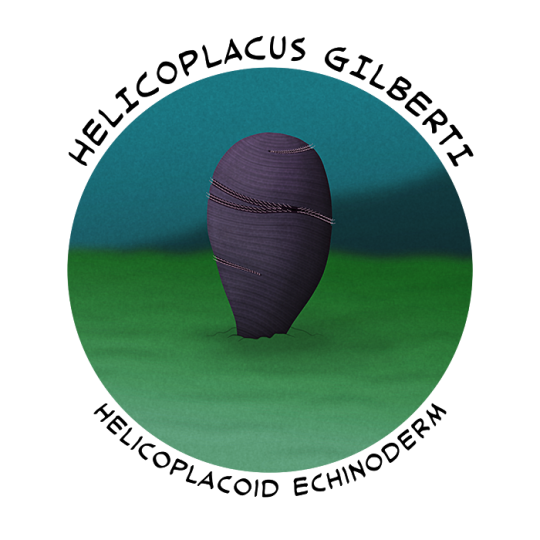

Cambrian Explosion Month #12: Phylum Echinodermata – Radial Revolution
While many of the earliest echinoderms had bizarre asymmetrical forms, at some point members of their lineage adopted radial symmetry instead – a development that would eventually lead to the familiar five-way symmetry of most modern species.
And they may have transitioned to that via three-way symmetry.
Helicoplacus gilberti is known from California, USA, and dates to around 525 million years ago. About 7cm tall (2.75"), it had what appears to be three feeding grooves on a body twisted around into a spiralling cigar shape, and it would have lived standing upright with its base buried into soft muddy sediment or microbial mats.
As one of the oldest definite echinoderms in the fossil record, for a long time it was thought to be an extremely "primitive" basal form possibly ancestral to all other groups in the phylum. Its confusing anatomy didn't help, with debates over the location of its mouth and whether its twisting body was really triradially symmetric or not, but more recent studies have suggested it was actually much closer related to modern echinoderms than to the weird asymmetrical ones.
The discovery of a closely related species named Helicocystis shows a potential transitional form between helicoplacoids and pentaradial echinoderms – a spiral Helicoplacus-like body, but with five feeding grooves, and a small attachment stalk at its base that resembles those of early five-rayed groups like eocrinoids.
This would also mean that all the early echinoderm lineages diverged from their common ancestors even more rapidly than previously thought, developing body plans ranging from bilateral to asymmetric to pentaradial within just a few million years in the early Cambrian.
———
Eocrinoids were some of the first pentaradial echinoderms to have both attachment stalks and erect feeding appendages, and were the ancestral members of a group called the blastozoans, but it's not clear if they were actually ancestors or close relatives of modern crinoids. Traditionally crinoids are thought to have evolved from blastozoans, but other studies suggest their similarities might be convergent and crinoids could instead be descended from another group called edrioasteroids.
Guizhoueocrinus yui was an early eocrinoid with a vase-shaped body and a thick stem. Known from southwest China, about 516-513 million years ago, its five arms split into pairs of spirally coiled appendages near their bases, giving it a total of ten.
It grew to around 6cm tall (2.4"), and spent its life filter-feeding while attached to hard surfaces on the sea floor, such as the shells of brachiopods, trilobites, and hyoliths – possibly while some owners of the shells were still alive, and sometimes with multiple individuals found on the same shell.
Another potential link between Helicoplacus and early pentaradial echinoderms also comes from Guizhoueocrinus, with evidence of a "crypto-helical" spiral arrangement of its skeletal plates.
The eocrinoids were the most diverse and successful echinoderms during the Cambrian, and went on to survive until the late Silurian, while other blastozoans descended from them lasted up until the end-Permian mass extinction 250 million years ago. (…Unless crinoids are blastozoans, in which case some descendants of eocrinoids are still alive today.)
———
Nix Illustration | Tumblr | Pillowfort | Twitter | Patreon
#science illustration#paleontology#paleoart#palaeoblr#cambrian explosion 2021#echinoderm#helicoplacus#guizhoueocrinus#gogiida#eocrinoidea#blastozoa#ambulacraria#deuterostome#bilateria#eumetazoa#animalia#art
86 notes
·
View notes